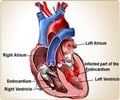A new molecular pathway that is linked with heart failure has been identified by researchers at Case Western Reserve University School of Medicine.

"As a practicing cardiologist, it is clear that current heart failure drugs fall alarmingly short for countless patients. Our discovery heralds a brand new class of drugs which work within the cell nucleus and offers promise to millions suffering from this common and lethal disease," said Saptarsi Haldar, MD, senior author on the paper, assistant professor of medicine at Case Western Reserve and cardiologist at University Hospitals Case Medical Center.
Heart failure occurs when the organ's pumping capacity cannot meet the body's needs. Existing drugs, most of which block hormones such as adrenaline at the cell's outer surface, have improved patient survival. Unfortunately, several clinical studies have demonstrated that heart failure patients taking these hormone-blocking drugs still succumb to high rates of hospitalization and death. Leveraging a new approach, the research team turned their attention from the cell's periphery to the nucleus - the very place that unleashes sweeping damage-control responses which, if left unchecked, ultimately destroy the heart.
The team found that a new family of genes, called BET bromodomains, cause heart failure because they drive hyperactive stress responses in the nucleus. Prior research linking BET bromodomains to cancer prompted the laboratory of James Bradner, MD, the paper's senior author and a researcher at the Dana-Farber, to develop a direct-acting BET inhibitor, called JQ1. In models of cancer, JQ1 functions to turn off key cancer-causing genes occasionally prompting cancer cells to "forget" they are cancer. In models of heart failure, JQ1 silences genetic actions causing enlargement of and damage to the heart - even in the face of overwhelming stress.
"While it's been known for many years that the nucleus goes awry in heart failure, potential therapeutic targets residing in this part of the cell are often dubbed as undruggable' given their lack of pharmacological accessibility," said Jonathan Brown, MD, cardiologist at Brigham and Women's Hospital and co-first author on the paper. "Our work with JQ1 in pre-clinical models shows that this can be achieved successfully and safely."
The team led by principal investigators Haldar and Bradner studied mice who develop classic features of human heart failure, including massively enlarged hearts that are full of scar tissue and have poor pumping function.
Advertisement
"Remarkably, at the end of the experiment, the hearts of many JQ1 treated mice appeared healthy and vigorous, despite being exposed to persistent and severe stress," said Priti Anand, a researcher in Haldar's lab and co-first author on the paper. "We knew we were on to something big the first time we saw this striking response."
Advertisement
"So much has been learned from this molecule," noted Bradner. "The fundamental similarity between the biology of cancer cell growth and heart enlargement following extraordinary stress connects these mature fields of study in new and exciting ways, of immediate relevance to drug development. This study best exemplifies the power of open-source approaches to drug discovery."
In the coming months, the team will test JQ1 in preclinical models of heart failure and other cardiovascular conditions. With the jumpstart offered by Bradner's creation of JQ1, the research team hopes to one day move to clinical trials.
Charles Lin, PhD, of the Dana-Farber Cancer Institute was also a lead-author on the study. Key collaborators on this research also included Jorge Plutzky, Brigham and Women's Hospital; Jun Qi, Dana-Farber; Madeleine Lemieux, BioInfo; Thomas Cappola and Kenneth Margulies, University of Pennsylvania Perelman School of Medicine; and Rongli Zhang, Pedro Calderon Artero, M. Amer Alaiti, Jace Bullard, and Kareem Alazem of Case Western Reserve University School of Medicine.
This research was funded by National Institutes of Health grants including NIH-R01 DK093821, NIH-K08 HL086614, NIH-R01 HL105993, NIH-K08 HL105678, NIH-K08 CA128972, and NIH-T32 HL105338. Additional support was provided by The Hartwell Foundation, Visconsi Research Scholars Fund, the Burroughs-Wellcome Fund, the Damon-Runyon Cancer Research Foundation, the Richard and Susan Smith Family Foundation, and U.S. Department of Defense.
About Case Western Reserve University School of Medicine Founded in 1843, Case Western Reserve University School of Medicine is the largest medical research institution in Ohio and is among the nation's top medical schools for research funding from the National Institutes of Health. The School of Medicine is recognized throughout the international medical community for outstanding achievements in teaching. The School's innovative and pioneering Western Reserve2 curriculum interweaves four themes--research and scholarship, clinical mastery, leadership, and civic professionalism--to prepare students for the practice of evidence-based medicine in the rapidly changing health care environment of the 21st century. Nine Nobel Laureates have been affiliated with the School of Medicine.
Annually, the School of Medicine trains more than 800 MD and MD/PhD students and ranks in the top 25 among U.S. research-oriented medical schools as designated by U.S. News & World Report's "Guide to Graduate Education."
The School of Medicine's primary affiliate is University Hospitals Case Medical Center and is additionally affiliated with MetroHealth Medical Center, the Louis Stokes Cleveland Department of Veterans Affairs Medical Center, and the Cleveland Clinic, with which it established the Cleveland Clinic Lerner College of Medicine of Case Western Reserve University in casemed.case.edu
Source-Newswise















